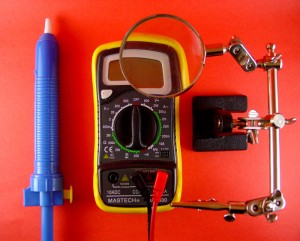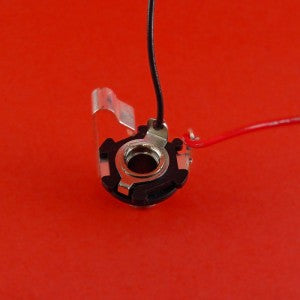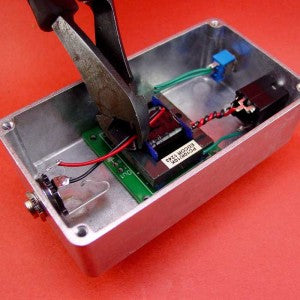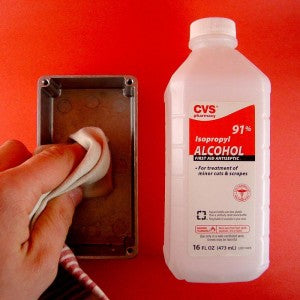LINE2AMP RevC v2 Assembly Guide
If you purchased your kit before 2/13/2012, please see the RevC v1 Assembly Guide.Safety Precautions, Warranty, and Disclaimer Improper soldering and handling of electricity can cause serious injury and damage to your property. Read and understand the instructions below before beginning your project. Follow the instructions, build carefully, and use the appropriate tools. Build at your own risk. DIY Recording Equipment, LLC is not responsible for any damage or injury resulting from the assembly or use of your LINE2AMP kit. You are the manufacturer of your LINE2AMP. It is your responsibility to turn this group of parts into a working piece of recording equipment. DIY Recording Equipment, LLC does not guarantee the success of your project and disclaims any Implied Warranty of Merchantability. Please visit the support forum for assembly support. Damaged or Missing Parts All kits and parts are checked before being shipped to you. If something arrives damaged or if your kit is missing a part, please contact me directly via this contact form to inquire about a replacement. Missing parts will be replaced at my expense. Damaged parts should be returned to me for verification. If the part shows signs of use beyond what was necessary to determine that it was damaged, DIY Recording Equipment, LLC reserves the right not to replace the part.
Required Tools
It's possible to complete the LINE2AMP with only three hand tools and a spool of solder. See the Tools page for gear recommendations.
Optional Tools
A multi-meter and desoldering tool are essential for troubleshooting and replacing faulty or misplaced components. A "helping hands" tool is great for magnifying and stabilizing your work surface.

Transformer Testing
Test the transformer before you begin soldering. Perform the following measurements with a multi-meter set to read resistance: Probe pins 1 (indicated by a notch on the transformer) and 3 with your multi-meter leads. The resistance should be about 434Ω. If you do not get a reading, make sure your meter's threshold is set to at least 2kΩ. Probe pins 5 and 7. The resistance should be in the region of 114Ω.
1
Identify resistors and bend leads. Resistors are identified by the electronic color code (Wikipedia).
2
Insert the resistors into their respective places on the PCB and bend their leads slightly. Turn the board over for soldering.
3
Solder the resistors, heating each joint for 5-8 seconds and applying a small dab of solder. After soldering, clip the leads as close to the solder joints as possible without damaging the joints themselves.
4
Insert the transformer into the PCB, matching Pin 1 (indicated by a notch on the blue plastic of the transformer) to the square pad on the PCB. Because the transformer is the most heat-sensitive component in the project, be careful to heat each pin for no longer than 5-8 seconds while soldering. Alternate soldering between the rows of pins to allow time for each winding to cool down. Trim the leads as in step 3.
5
Locate the pre-trimmed and stripped pieces of hookup wire included with your kit. Remove the small lengths of excess coating and tin the exposed bare wire by applying a small amount of solder.
6
Insert two of the green lengths of wire into the lugs of the ground-lift switch with their tinned tips facing outward as shown.
7
Solder the wires to the switch, heating each lug for no longer than five seconds to avoid overheating the plastic.
8
Solder lengths of green, red, and black wire to the pins of the input jack as shown. Green corresponds to the sleeve/ground pin, red to the tip/signal "hot" pin, and black to the ring/signal "cold" pin. Note that the sleeve/ground pin is indicated by a 45 degree angle on the corner of the jack body. Depending on parts availability, your kit may come with 5-pin "switching" TRS jacks. In this case, simply ignore the two pins adjacent to the sleeve/ground pin and solder to the three pins shown in the picture.
9
Solder the remaining lengths of wire to the output jack. Red corresponds to the tip/signal pin and black to the sleeve/ground pin.
10
Place the assembled PCB in the center of the case and the jacks and switch in their respective holes. Trim the hookup wires so that they just reach the blue, plastic part of the transformer.
11
Solder the input jack to the PCB. The pads are labeled "T," "R," and "S" for the tip, ring, and sleeve pins of the jack. Red -> T, Black -> R, Green -> S.
12
Complete the PCB by connecting the switch and output jack. As with the input jack, solder the red wire of the output jack to the pad marked "T" and the black wire to the pad marked "S." The switch wires do not need to be soldered to a particular pad.
13
If you have a multi-meter, it's a good idea to test the completed circuit before installing it in the case. Set your meter to read resistance with a range of at least 2k and place the probes on the tip and ring pins of the input jack (orientation does not matter). Your meter should read between 1kΩ and 1.4kΩ.
14
Increase the resistance range to 20k and place the probes on the pins of the output jack. The resistance should be close to 15kΩ. If either of these test readings are not correct, please post your problem at the Support Forum.
15
Prepare the inside of the case for the adhesive standoffs. Clean the surface with a cloth moistened with water or isopropyl alcohol.
16
Note: Steps 16 and 17 do not apply to kits purchased after 9/20/2013, which include screw-mount standoffs. Push the standoffs into the four PCB mounting holes. Persist until you hear and feel a satisfying "click."
17
Remove the covers from the adhesive standoffs and install the PCB into the case. Apply pressure for 30 seconds. Install the switch and jacks into their respective holes.
Fin
Congratulations on completing your LINE2AMP! Now go abuse some guitar amps. If your LINE2AMP is not working, please visit the Support Forum.




















